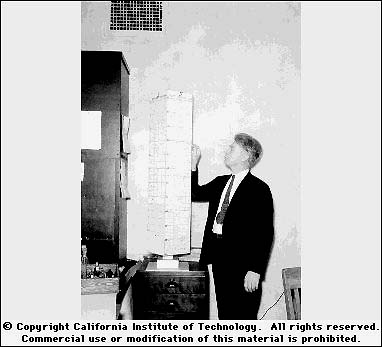Calvin Bridges, 1935

Calvin Bridges pointing to Drosophila map pillar, a method of identification he devised. Each side of the pillar represented one Drosophila chromosome, around 1935.
calvin bridges, pillar, drosophila chromosome, map, gallery 11, 1935
- ID: 16291
- Source: DNALC.DNAFTB
Related Content
16290. Gallery 11: Calvin Bridges at Caltech, 1935
Calvin Bridges in Fly Stock Room in Caltech, around 1935. Fly stocks now had their own room as opposed to being stacked on people's desks.
16288. Gallery 11: Calvin Bridges at Woods Hole, 1922
Calvin Bridges pitching horseshoes at Woods Hole, 1922.
16289. Gallery 11: Calvin Bridges at Columbia, ca 1926
Calvin Bridges in Fly Room at Columbia around 1926. Note the crowded conditions.
16292. Gallery 11: Calvin Bridges, 1937
Calvin Bridges during a stay at Cold Spring Harbor Laboratory, 1937.
16298. Biography 11: Calvin Blackman Bridges (1889-1938)
Calvin Bridges was a student of Thomas Hunt Morgan. Bridges advanced the theory of chromosomal non-disjunction, and did a lot of work on chromosomal banding patterns.
16284. Gallery 11: Alfred Sturtevant at Caltech, 1930
Biology staff at Caltech, 1930.
16297. Biography 11: Alfred Henry Sturtevant (1891-1970)
Alfred Sturtevant was a student of Thomas Hunt Morgan. Sturtevant provided proof of genetic linkage.
16277. Biography 10: Thomas Hunt Morgan (1866-1945)
Thomas Hunt Morgan was one of the first true geneticists.
16993. New York Stories: Exploring Mutant Organisms - The Fly Room
New York high school students set out to find Thomas Hunt Morgan's "Fly Room" at Columbia University, where seminal genetics research took place in the early 20th century.
15519. Chromosome map, 3D animation with no audio
Chromosome map, 3D animation with no audio












